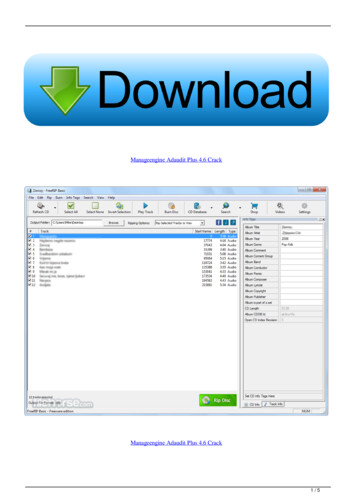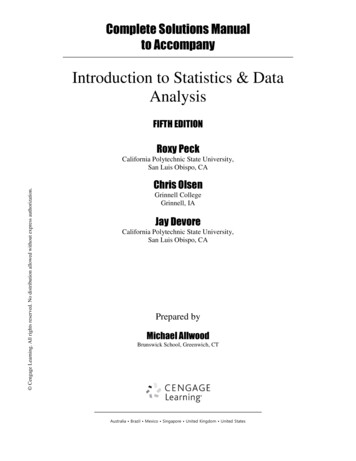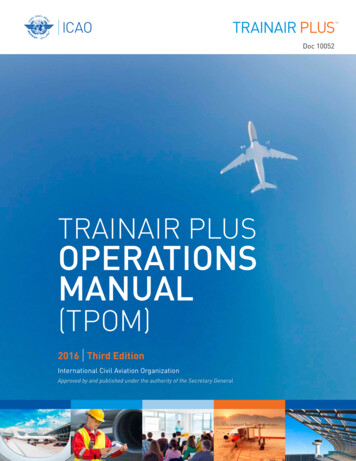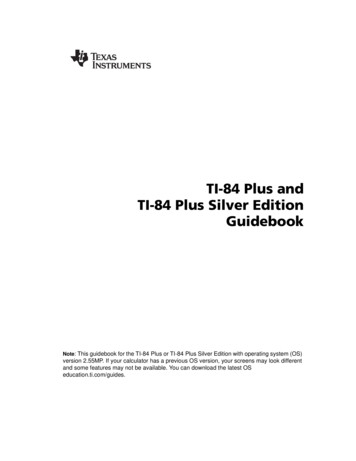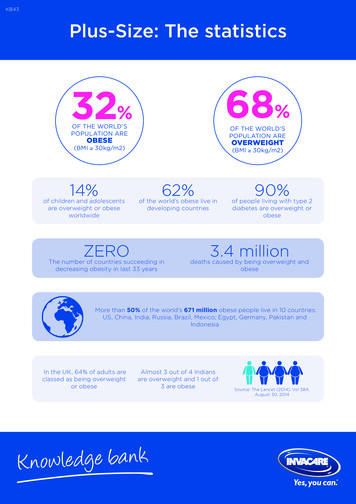
Transcription
KB43Plus-Size: The statistics32%68%OBESEOVERWEIGHTOF THE WORLD’SPOPULATION AREOF THE WORLD’SPOPULATION ARE(BMI 30kg/m2)14%of children and adolescentsare overweight or obeseworldwideZERO(BMI 30kg/m2)62%of the world’s obese live indeveloping countriesThe number of countries succeeding indecreasing obesity in last 33 years90%of people living with type 2diabetes are overweight orobese3.4 milliondeaths caused by being overweight andobeseMore than 50% of the world’s 671 million obese people live in 10 countries:US, China, India, Russia, Brazil, Mexico, Egypt, Germany, Pakistan andIndonesiaIn the UK, 64% of adults areclassed as being overweightor obeseAlmost 3 out of 4 Indiansare overweight and 1 out of3 are obeseSource: The Lancet (2014), Vol 384,August 30, 2014
KB24Plus-Size: The statisticsPrevalence of overweight and obeseGender and groups in European regions, 2013Central EuropeEastern EuropeWestern %20%21%15%10%OVERWEIGHTAND OBESEOBESEOVERWEIGHTAND OBESEMen 20 yearsOBESEWomen 20 yearsNote: Obesity BMI 25 and obesity 2 BMI 30kg/m2. The prevalence of overweight and obesity forNote: Obesity BMI 25 and obesity BMI 30kg/m . The prevalence of overweight and obesityfor menandwomen separatelyand for17 agegroups(fromgroups2-4 years (fromto 80 years)menandwomenseparatelyandfor17 age2-4 years to 80 years)Source: The Lancet (2014), Vol 384, August 30, 2014Source: The Lancet (2014), Vol 384, August 30, 2014Obesity patterns (BMI 30)Number of obese people, Aged 20 120Millions100 13% CAGR806040201995200520152025Western EuropeSource: The Lancet (2014), Vol 384, August 30, 20142035
Plus-Size: The statisticsObesity patterns (BMI 30)Number of obese people, Aged 20 14012010089Millions100798060505864674240Forecast tern EuropeSource: The Lancet (2014), Vol 384, August 30, 2014BMI classificationThe classification of weight category by BMIClassificationBMI (KG/M2)BMI (KG/M2)Normal 25.0-27.427.5-29.9Obese Class 130.0-34.930.0-32.432.5-34.9Obese Class 235.0-39.935.0-37.437.5-39.9Obese Class 3 40.0 40.0For Asian populations. classifications remain the same as the international classification, but the public health action points forinterventions are set at 23, 27.5, 32.5 and 37.5 kg/m2.Source: Adapted from the World Health Orginisation (WHO) 2004.
Plus-Size: The statisticsObesity according to age groupMen WomenMen WomenMen WomenCentral EuropeEastern EuropeWestern Europe50%45%Percentage40%35%30%25%20%15%10%5%80 75 to 7970 to 7465 to 6960 to 6455 to 5950 to 5445 to 4940 to 4435 to 3930 to 3425 to 2920 to 2415 to 195 to 910 to 142 to 40%Age GroupNote: Obesity BMI 30kg/mSource: The Lancet (2014), Vol 384, August 30, 20142Obesity in adults by yearMen WomenMen WomenCentral EuropeEastern EuropeMen WomenWestern 199520002005YearSource: The Lancet (2014), Vol 384, August 30, 201420102015
Plus-Size: The statisticsReferences Beitz, J. M. Providing Quality Skin and Wound Care for the Bariatric Patient: An Overview of Clinical Challenges. Ostomy WoundManagement, 2014. Blickenstorfer, C. H. Bariatric Ergonomics – Transfer and Mobility of the Obese Patient. NAAFA, 2002. Brizell, J., Stuart, J., McVeigh, J. & Irvine, F. Evaluation of the Bariatric Care Pathway: Prospective Patients. NHS Wirral, 2012. Burlis, T. L. Physical Therapy for the Client Pre/ Post-Bariatric Surgery. Washington University Program in Physical Therapy, 2010. Camden, S. G. What is Bariatrics? Ostomy Wound Management, 2008. Clark, F., Reingold, F. S. & Salles-Jordan, K. Obesity and OccupationalTherapy (Position Paper). The American Journal of Occupational Therapy, 2017. Camden, G. Does skin care for the obese patient require adifferent approach? Roundtable discussion. Bariatric Nurse Surgery Patient Care, 2006. Cohen, M. H., et al. Patient handling and movementassessments: A white paper. Facilities Guidelines Institute, 2010. Costanho, R. & Oliveira, G. B. Major Dermatological Changes in Obese Patients.ABCD Arq Bras Cir Dig, 2011. Cowdell, F. & Radley, K. Skin hygiene for patients with bariatric needs. Nursing Practice Review, 2014. Cowley, S. & Leggett, S. Manual handling risks associated with the care, treatment and transport of bariatric (severely obese) patients and clientsin Australia. Australian Safety & Compensation Council, 2009. Dionne, M. Evaluation of the Bariatric Patient (Key Considerations). BariatricInservice, 2010. Dyck, S., Rodrigue, A. & Lim, P. L. Special Considerations for Care of Obese Patients. Victoria General Hospital, 2008. FroehlichGrobe, K. & Lollar, D. Obesity and Disability: Time to Act. American Journal of Preventive Medicine, 2011. Gallagher, S. Obesity and the AgingAdult: ideas for promoting patient safety and preventing caregiver injury. Clinics in Geriatric Medicine, 2005. Gallagher, S. Obesity: An EmergingConcern for Patients and Nurses. The Online Journal of Issues in Nursing, 2009. Gallagher, S. Panniculectomy: Implications for Care. Perspectives,2008. Gallagher, S. The Challenges of Obesity and Skin Integrity. Elsevier Saunders, 2005. Hahler, B. Morbid Obesity: A nursing Care challenge.MEDSURG Nursing, 2002. Hignett, S., Chipchase, S., Tetley, A. & Griffiths, P. Risk Assessment and Process, 2007. Hillenbrand, A., Henne-Bruns,D. & Wolf, A. M. Panniculus, giant hernias and surgical problems in patients with morbid obesity. GMS Interdisciplinary Plastic and ReconstructiveSurgery, 2012. Kramer-Jackman, K. & Kramer, D. Bariatric Hospital Bed Safety and Selection. Bariatric Nursing and Surgical Patient Care, 2010. Krasner, D.L., Kennedy-Evans K.L., Henn, T. et al. Bariatric Wound Care: Common Problems and Management Strategies. Bariatric Times, 2006. Krasner, D.L., Rodeheaver, G.T. & Sibbald, R.G. Chronic Wound Care: A Clinical Source Book for Healthcare Professionals. HMP Communications,2007. Kroll, K. Evidence-based design in healthcare facilities. Building Operating Management, 2005. Lange, M. L. & Minkel, J. L. Seating andWheeled Mobility - A Clinical Resource Guide. SLACK Incorporated, 2018. Lawson, B. Evidence based design in healthcare. Business Briefing:Hospital Engineering & Facilities Management, 2005. Levine, J. M. Considerations in Special Populations: Patients with Vulnerable Skin. NationalPressure Ulcer Advisory Panel, 2015. Lowe, J. R. Skin Integrity in Critically Ill Obese Patients. National Institute of Health, 2009. Malone, E. &Dellinger, B. Furniture design features and healthcare outcomes. The Center for Health Design, 2011. Mastrogiovanni, D., Phillips, E.M. & Fine, C.K.The bariatric spinal cord — injured person: challenges in preventing and healing skin problems. Top Spinal Cord Injury Rehabil, 2003. Matsumoto, M., Ogai, K., Aoki, M., Yokogawa, M., Tawara, M., Sugama, J., Minematsu, T., Nakagami, G., Dai, M. & Sanada, H. Relationshipbetween Dermal Structural Changes on Ultrasonographic Images and Skin Viscoelasticity in Overweight and Obese Japanese Males. ScientificResearch Publishing, 2016. McClean, K. M., Kee, F., Young, I. S. & Elborn, J. S. Obesity and the lung: Epidemiology. Thorax, 2008. Morello, S.S. Considerations for Bariatric Patients in Pressure Injuries and Wound Care. National Pressure Ulcer Advisory Panel, 2017. Muir, M. & ArcherHeese, G. Essentials of a Bariatric Patient Handling Program. American Nurses Association, 2009. Muir, M. & Rush, A. Moving and handling ofplus size people – an illustrated guide. A National Back Exchange Publication, 2013. Owens, K. Treatment/ Transport of Bariatric Patients. GlobeManufacturing, 2012. Palfreyman, S. The Impact of Obesity on the Development and Care of Acute and Chronic Wounds. Wound Care Canada,2016. Parkyn, W. R., Chan, C. Y. & Rij, A. M. V. Skin Problems in the Lower Legs of Morbidly Obese Patients and the Possible Role of BariatricSurgery. Journal of Obesity & Weight Loss Therapy, 2014. Pelczarski, K. Basic concerns in bariatrics. Healthcare Design Magazine, 2007. Pokorny, M.E. Lead in skin physiology and disease in the obese. Bariatric Nursing Surgery Patient Care, 2008. Pokorny, M. E, Scott, E., Rose, M.A., Baker, G., Seanson, M., Waters, W., Watkins, F. & Drake, D. Challenges in Caring for Morbidly Obese Patients. Home Healthcare Nurse, 2009. Reingold, F. S. Obesity and Occupational Therapy. The American Journal of Occupational Therapy. 2013 Rolin, S. The right to drive: Wheelchairprescription with transportation in mind. HomeHealthCare . Rush, A. Bariatric Care: Pressure Ulcer Prevention. Wound Essentials, 2009. Shoemake, S. & Stoessel, K. Pressure Ulcers in the Surgical Patient. Kimberly-Clark Health Care Education, 2007. Smith, A. Considerations inthe care of the Bariatric Patient. PT, DPT, 2016. Strongwater, D. & Becker, F. The Inclusion of the Bariatric Population - Providing greater patientaccess at a community based hospital, 2009 Stapleton, P. A., James, M. E., Goodwill, A. G. & Frisbee, J. C. Obesity and Vascular Dysfunction.Pathophysiology, 2009. Taylor, S. J. Seating and Mobility Considerations for the Bariatric Client. Directions Clinical Corner, 2013. The Lancet.China Medical Board: a century of Rockfeller health Philanthropy, 2014. Tsigosa, C., Hainerb, V., Basdevantc, A., Finerd, N., Friede, M., MathusVliegenf, E., Micicg, D., Maislosh, M., Romani, G., Schutzj, Y., Toplakk, H. & Zahorska- Markiewiczl, B. Management of Obesity in Adults: EuropeanClinical Practice Guidelines. For the Obesity Management Task Force of the European Association for the Study of Obesity, 2008. Trayes, K. P., Studdiford, J. S., Pickle, S. & Tully, A. S. Edema: Diagnosis and Management. America Academy of family Physicians, 2013. Villela, N. R., Kramer- Aguiar, L. G., Bottino, D. A., Wiernsperger, N. & Bouskela, E. Metabolic disturbances linked to obesity: the role of impairedtissue perfusion. Arq Bras Endocrinol Metab, 2009. Vollmann, K., Garcia, R. & Miller, L. Interventional Patient Hygiene: Proactive (Hygiene)Strategies to Improved Patients’ Outcomes. AACN, 2005. Watanade, L. The Anatomy of Bariatric Mobility. Mobility Management, 2010. Wignall, D. Design as a Critical Tool in Bariatric Patient Care. Journal of Diabetes Science and Technology, 2008. Williams, D. S. Design withdignity: The design and manufacture of appropriate furniture for the bariatric patient population. Bariatric Nursing and Surgical Patient Care, 2008. World Health Organization. Obesity; Preventing and Managing the Global Epidemic. Report of the World Health Organisation Consultation onObesity, 2000. Yumuk, V., Tsigos, C., Fried, M., Schindler, K., Busetto, L., Micic, D. & Toplak, H. European Guidelines for Obesity. The EuropeanJournal of Obesity, 2015.Invacare International GmbHBenkenstrasse 2604108 Witterswil SwitzerlandTel: 41 61 487 70 70hqeurope@invacare.comwww.invacare.eu.com 2017 Invacare International GmbHAll rights reserved.Invacare Plus size - Statistics - EU - 05/2018
KB24 Plus-Size: The statistics Note: Obesity BMI 25 and obesity BMI 30kg/m2.The prevalence of overweight and obesity for men and women separately and for 17 age groups (from 2-4 years to 80 years) Source: The Lancet (2014), Vol 384, August 30, 2014 Note: Obesity BMI 2 25 and obesity BMI 30kg/m .



